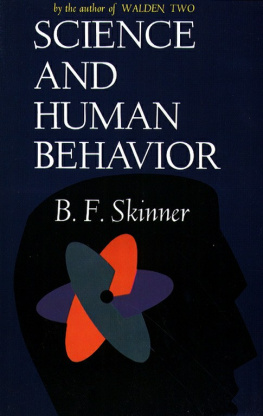Paul Naour (auth.) - E.O. Wilson and B.F. Skinner: A Dialogue Between Sociobiology and Radical Behaviorism
Here you can read online Paul Naour (auth.) - E.O. Wilson and B.F. Skinner: A Dialogue Between Sociobiology and Radical Behaviorism full text of the book (entire story) in english for free. Download pdf and epub, get meaning, cover and reviews about this ebook. year: 2009, publisher: Springer-Verlag New York, genre: Science. Description of the work, (preface) as well as reviews are available. Best literature library LitArk.com created for fans of good reading and offers a wide selection of genres:
Romance novel
Science fiction
Adventure
Detective
Science
History
Home and family
Prose
Art
Politics
Computer
Non-fiction
Religion
Business
Children
Humor
Choose a favorite category and find really read worthwhile books. Enjoy immersion in the world of imagination, feel the emotions of the characters or learn something new for yourself, make an fascinating discovery.
- Book:E.O. Wilson and B.F. Skinner: A Dialogue Between Sociobiology and Radical Behaviorism
- Author:
- Publisher:Springer-Verlag New York
- Genre:
- Year:2009
- Rating:5 / 5
- Favourites:Add to favourites
- Your mark:
E.O. Wilson and B.F. Skinner: A Dialogue Between Sociobiology and Radical Behaviorism: summary, description and annotation
We offer to read an annotation, description, summary or preface (depends on what the author of the book "E.O. Wilson and B.F. Skinner: A Dialogue Between Sociobiology and Radical Behaviorism" wrote himself). If you haven't found the necessary information about the book — write in the comments, we will try to find it.
This is going to be a conversation that I will have with B.F. Skinner. This is Ed Wilson. He invited me by to talk about sociobiology. Thus began a 1987 conversation between E.O. Wilson, who embodies sociobiology, and B.F. Skinner, who personifies radical behaviorism. The two Harvard colleagues shared a common interestbut very different perspectivesin behavior, human nature, and culture. They also shared years of exaggerated and ideologically-based claims regarding the perceived controversial nature of their work. However, the passage of over twenty years places their conversation in a very different evolutionary context that is the unifying theme of this book and Paul Naours inspiration to cleverly describe the relationship of their work.
Naour uses the conversation as a centerpiece around which he offers readers thought-provoking insight regarding how we can push the rigid boundaries of discipline-based dogmatism to understand the evolutionary relationships between sociobiology and radical behaviorism. Wilson (1998) challenges us to understand a balanced perspective cannot be acquired by studying disciplines in pieces but through pursuit of the consilience among them. Such unification will come hard. Wilson recently observed that What (Naour) has written is excellent, and will be an outstanding addition to the history of ideas.
During this sesquicentennial year of The Origin of Species and the bicentennial of Darwins birth, B.F. Skinner and E.O. Wilson: A Dialogue Between Radical Behaviorism and Sociobiology is an essential read for anyone interested in the evolutionary basis of human behavior. The book challenges readers to push beyond the boundaries of Wilson and Skinner, suggests relationships to current work, and inspires curiosity regarding how that work can provide additional insight to the biological basis of human culture. It will also appeal to those with interest in the contemporary history of science or psychology, and is written for a broad readership to provoke renewed consideration of Wilson and Skinner.
Paul Naour (auth.): author's other books
Who wrote E.O. Wilson and B.F. Skinner: A Dialogue Between Sociobiology and Radical Behaviorism? Find out the surname, the name of the author of the book and a list of all author's works by series.








